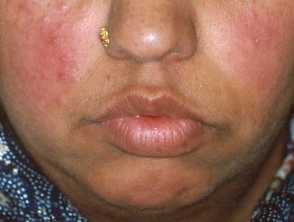
- Case-Based Roundtable
- General Dermatology
- Eczema
- Chronic Hand Eczema
- Alopecia
- Aesthetics
- Vitiligo
- COVID-19
- Actinic Keratosis
- Precision Medicine and Biologics
- Rare Disease
- Wound Care
- Rosacea
- Psoriasis
- Psoriatic Arthritis
- Atopic Dermatitis
- Melasma
- NP and PA
- Skin Cancer
- Hidradenitis Suppurativa
- Drug Watch
- Pigmentary Disorders
- Acne
- Pediatric Dermatology
- Practice Management
- Prurigo Nodularis
- Buy-and-Bill
News
Article
Elevated Plasma Calcitonin Gene-Related Peptide Levels in Patients With Rosacea May Open Door for New Therapeutic Approaches
Author(s):
One study uncovered high levels of CGRP in patients with rosacea, with levels not affected by age, sex, BMI, and other factors.
Image courtesy of DermNet

A recent study shed light on a potential factor in the pathophysiology and treatment routes for rosacea: calcitonin gene-related peptide (CGRP). The study, published in the Journal of the European Academy of Dermatology and Venereology, compared plasma levels of CGRP in patients with rosacea versus in otherwise healthy controls, finding elevated levels of CGRP in individuals with rosacea.1
CGRP, known for its role in vasodilation and inflammation, has gained attention as a possible mediator in rosacea in recent years. Triggered by factors such as capsaicin, CGRP is implicated in neurogenic vasodilation and immune modulation.2
Researchers hypothesized a link between elevated CGRP levels and rosacea, drawing parallels between rosacea and migraine, both of which share common triggers and pathophysiological, molecular, and therapeutic aspects.3
Participants in this study were selected from outpatient clinics and online interest groups. Patients were eligible for participation if they were between 18 and 65 years of age and met diagnostic criteria for rosacea, including having features of rosacea for a minimum of 1 year prior to examination and with features currently evident at the time of blood sampling.
All participants underwent thorough phenotypic evaluation by expert dermatologists. Individuals with comorbid migraine were analyzed separately to discern its potential influence.
Patients, including those with rosacea (n=123), underwent a single visit where various procedures were conducted either at specific medical centers or at a location chosen by the patient. Demographic information and diagnoses were gathered through interviews, and blood samples were collected and analyzed for plasma concentrations of CGRP.
The analysis was done using a validated assay, and to ensure objectivity, the samples were anonymized before testing. The severity of rosacea was assessed using 2 different tools: the Rosacea Area and Severity Index and Clinician's Erythema Assessment, both evaluated by the same physician.
As a result of this testing, researchers discerned that individuals with rosacea exhibited significantly elevated plasma CGRP levels compared to healthy controls, independent of migraine comorbidity.
Additionally, no significant associations were found between CGRP levels and rosacea severity, subtypes, or specific features. However, a negative correlation emerged between CGRP levels and the duration of rosacea symptoms.
"In the groups with rosacea (with and without migraine), participants were significantly older than in the healthy group (approximately 10 years difference between each group)," wrote study authors. "Data on age-related CGRP level changes in healthy group are incomplete. One study comparing plasma CGRP in healthy people and patients with posttraumatic headache shows no signal in CGRP changes with age in healthy individuals. In vitro studies in rodents show that CGRP concentration in multiple tissues including areas of the brain, bladder, kidney and testes declines with age. Another study found plasma levels of CGRP in rodents to be unaffected by age, whereas one study found plasma levels of CGRP to be increased in older rodents. In our data set we failed to find any age-dependent difference in plasma CGRP levels in neither patients with rosacea nor in healthy controls."
Potential study limitations included the presence of comorbid migraine, which raises the possibility of confounding effects, and age and sex disparities among study groups.
"Our study provides evidence that plasma levels of CGRP are elevated in individuals with rosacea compared with healthy controls," according to Wienholtz et al. "However, we did not find a correlation between CGRP levels and rosacea severity or subtype, indicating that CGRP might not be a reliable biomarker for diagnosis or assessing the severity of rosacea. Nevertheless, our findings suggest that CGRP might be involved in the pathophysiology of rosacea. Further research is thus needed to investigate the potential of medications targeting CGRP signalling in managing rosacea."
References
- Wienholtz NKF, Christensen CE, Ashina H, et al. Elevated plasma levels of calcitonin gene-related peptide in individuals with rosacea: A cross-sectional case–control study. J Am Acad Dermatol. April 1, 2024. Accessed April 2, 2024. https://doi.org/10.1111/jdv.19954
- Steinhoff M, Urgen Schauber J, Leyden JJ, Schauber J, Leyden JJ. New insights into rosacea pathophysiology: a review of recent findings. J Am Acad Dermatol. 2013. Accessed April 2, 2024.
- Christensen CE, Andersen FS, Wienholtz N, Egeberg A, Thyssen JP, Ashina M. The relationship between migraine and rosacea: Systematic review and meta-analysis. Cephalalgia. 2018. Accessed April 2, 2024. doi:10.1177/0333102417731777
Newsletter
Like what you’re reading? Subscribe to Dermatology Times for weekly updates on therapies, innovations, and real-world practice tips.
2 Commerce Drive
Cranbury, NJ 08512
All rights reserved.





